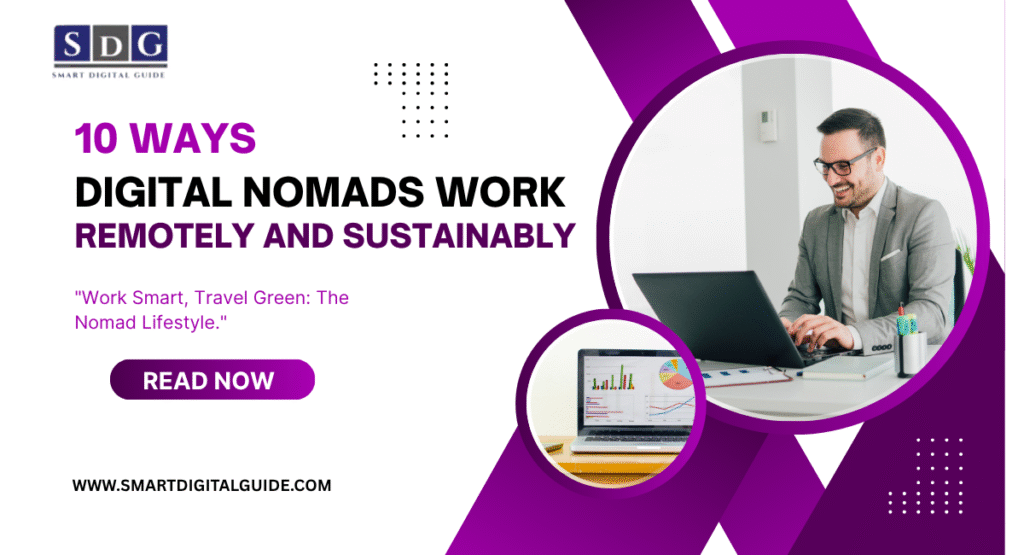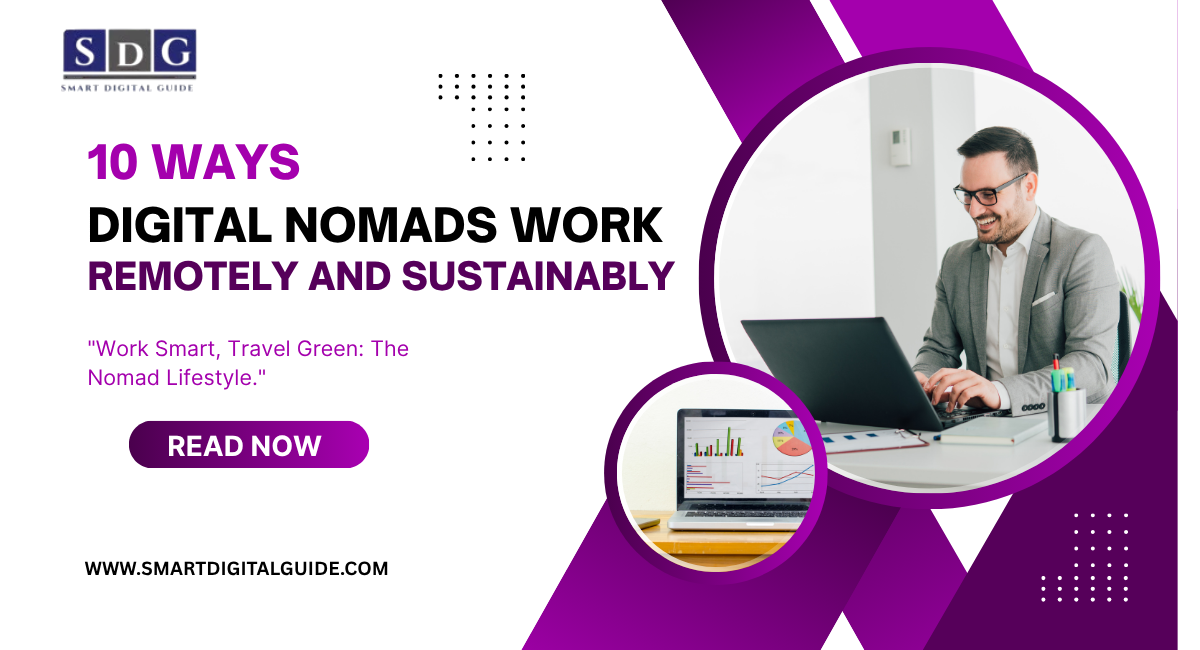In the modern digital landscape, Digital Nomads have transformed our perceptions of work. These individuals blend their professional lives with travel, leveraging technology to maintain productivity while discovering new places. However, beyond merely working from any location, a growing number of Digital Nomads are prioritizing sustainable practices aimed at minimizing their ecological footprint and achieving a harmonious lifestyle.
At Smart Digital Guide, we are convinced that remote work can align seamlessly with sustainability efforts. In this article, we will delve into 10 strategies that enable Digital Nomads to operate remotely in an eco-friendly manner while upholding productivity, adaptability, and a more environmentally-conscious way of living.

1. Choosing Eco-Friendly Workspaces
Instead of relying on energy-heavy offices, Digital Nomads often choose co-working environments with eco-friendly designs. An increasing number of these facilities leverage renewable energy sources, make use of natural lighting, and include energy-saving devices. This strategy not only reduces carbon emissions but also fosters a comfortable and healthy work environment.
2. Using Energy-Efficient Gadgets
Eco-friendly remote work begins with the use of energy-efficient gadgets. Devices such as laptops, smartphones, and portable chargers that consume minimal energy enable Digital Nomads to operate without squandering excess power. Additionally, solar-powered chargers and power banks have gained popularity among travelers who prioritize environmental sustainability.
3. Traveling with Minimal Carbon Footprint
A major hurdle for Digital Nomads is the need to decrease emissions associated with travel. Opting for slower transportation methods such as trains, buses, or carpooling rather than taking numerous flights can significantly lessen their carbon footprints. Additionally, many individuals participate in carbon offset initiatives to counterbalance their necessary travel emissions.
4. Working from Green Accommodations
Numerous Digital Nomads favor eco-conscious lodging options such as hostels, co-living environments, or Airbnbs that implement solar energy, collect rainwater, and have recycling initiatives. Choosing these types of accommodations not only lessens environmental impact but also encourages others to embrace sustainable habits.
5. Embracing the Cloud for a Paperless Lifestyle
With the help of cloud storage and digital resources, Digital Nomads can effortlessly steer clear of paper usage. Platforms such as Google Drive, Notion, and Dropbox allow for efficient online management of documents and projects. Adopting a paperless strategy is not only practical but also beneficial for the environment.
6. Supporting Local Businesses
Instead of relying on major corporations, Digital Nomads often opt to support local businesses, cafes, and markets in the places they visit. This approach not only benefits the local economies but also reduces the carbon footprint linked to large-scale production and long supply chains.
7. Practicing Minimalism
Digital Nomads operate with only what they can fit in backpacks or suitcases, inherently promoting a minimalist way of life. Having fewer possessions leads to reduced waste, decreased consumption, and a greater emphasis on experiences over material goods. Additionally, minimalism enhances the convenience and efficiency of travel and remote work.
8. Balancing Work and Wellness
A sustainable way of living encompasses not only ecological considerations but also individual wellness. Digital Nomads emphasize mental health through adaptable routines, engaging in yoga, or meditating to alleviate stress. This equilibrium helps them stay effective without succumbing to burnout.
9. Leveraging Renewable Energy
Certain Digital Nomads choose to invest in compact solar panels or environmentally friendly generators to power their devices on the go. This approach allows them to work remotely without depending on fossil fuels. Additionally, numerous co-working spaces incorporate renewable energy solutions to assist remote professionals.
10. Using Remote Work Tools for Collaboration
Instruments such as Zoom, Slack, and Trello enable Digital Nomads to work together without the need for excessive travel. This online method not only conserves time and resources but also minimizes the environmental effects associated with commuting or face-to-face gatherings.
Final Thoughts
The way of life for Digital Nomads encompasses more than simply working from scenic locations like beaches or mountain lodges; it involves crafting a future in which employment, travel, and environmental sustainability harmoniously blend. By selecting environmentally-friendly devices, backing local enterprises, and opting for renewable energy sources, they are demonstrating that remote work can be efficient as well as ecologically sound.
At Smart Digital Guide, we urge all potential Digital Nomads to integrate these sustainable habits into their journey toward a remote career. It’s an opportunity to work intelligently, travel with care, and contribute positively to the environment.









